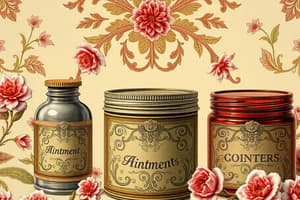Podcast
Questions and Answers
An occlusive ointment prevents water evaporation from the skin.
An occlusive ointment prevents water evaporation from the skin.
True (A)
Oleaginous bases are compounds built up from carbon and oxygen.
Oleaginous bases are compounds built up from carbon and oxygen.
False (B)
Animal oil is a common component of oleaginous bases.
Animal oil is a common component of oleaginous bases.
True (A)
Emulsion bases are always water-free.
Emulsion bases are always water-free.
Fixed vegetable oil can be saturated with nitrogen to become solid at room temperature.
Fixed vegetable oil can be saturated with nitrogen to become solid at room temperature.
Oleaginous bases are easily absorbed by the skin.
Oleaginous bases are easily absorbed by the skin.
Vanishing cream is a water-washable base.
Vanishing cream is a water-washable base.
Cold cream is an occlusive base.
Cold cream is an occlusive base.
Hydrophilic ointment contains stearic acid.
Hydrophilic ointment contains stearic acid.
Propylene glycol is one of the antimicrobial preservatives.
Propylene glycol is one of the antimicrobial preservatives.
Emulsion base resembling cream is water-washable.
Emulsion base resembling cream is water-washable.
Sodium lauryl sulfate is present in the oleaginous phase of the emulsion.
Sodium lauryl sulfate is present in the oleaginous phase of the emulsion.
Oleaginous bases are used mainly for their drying effect on the skin.
Oleaginous bases are used mainly for their drying effect on the skin.
Mineral oil is an example of a hydrocarbon found in ointment bases.
Mineral oil is an example of a hydrocarbon found in ointment bases.
Yellow ointment contains more yellow wax than petrolatum.
Yellow ointment contains more yellow wax than petrolatum.
White petrolatum is preferred over yellow petrolatum due to its color.
White petrolatum is preferred over yellow petrolatum due to its color.
To prepare Yellow ointment, white wax is bleached yellow instead of yellow wax.
To prepare Yellow ointment, white wax is bleached yellow instead of yellow wax.
Liquid petrolatum is a mixture of saturated hydrocarbons obtained from water.
Liquid petrolatum is a mixture of saturated hydrocarbons obtained from water.
The fusion method is used when the base contains liquids that have higher melting points.
The fusion method is used when the base contains liquids that have higher melting points.
Aqueous solutions can be incorporated into hydrophobic ointment bases.
Aqueous solutions can be incorporated into hydrophobic ointment bases.
In the fusion method, the water phase is incorporated into the oil phase after both phases are cooled.
In the fusion method, the water phase is incorporated into the oil phase after both phases are cooled.
The fusion method involves combining components by melting them together and cooling without any stirring.
The fusion method involves combining components by melting them together and cooling without any stirring.
Spatulation should only be done when incorporating solids into the mixture, not for liquids.
Spatulation should only be done when incorporating solids into the mixture, not for liquids.
The fusion method is primarily used for solid medications that are not soluble in melted bases.
The fusion method is primarily used for solid medications that are not soluble in melted bases.
According to the USP, all topical preparations need to be sterile.
According to the USP, all topical preparations need to be sterile.
Storage of pharmaceutical ointments and creams should be done in a warm place to prevent product separation.
Storage of pharmaceutical ointments and creams should be done in a warm place to prevent product separation.
The labeling requirements for ointments and creams must include the type of base used according to the USP.
The labeling requirements for ointments and creams must include the type of base used according to the USP.
Preparations intended for urethral, rectal, and vaginal use do not need to be tested for the presence of molds and yeasts.
Preparations intended for urethral, rectal, and vaginal use do not need to be tested for the presence of molds and yeasts.
Viscosity and in vitro release are additional standards mentioned by the USP for pharmaceutical ointments and creams.
Viscosity and in vitro release are additional standards mentioned by the USP for pharmaceutical ointments and creams.
Flashcards are hidden until you start studying




